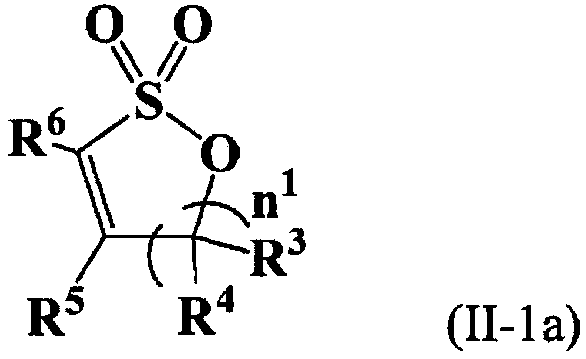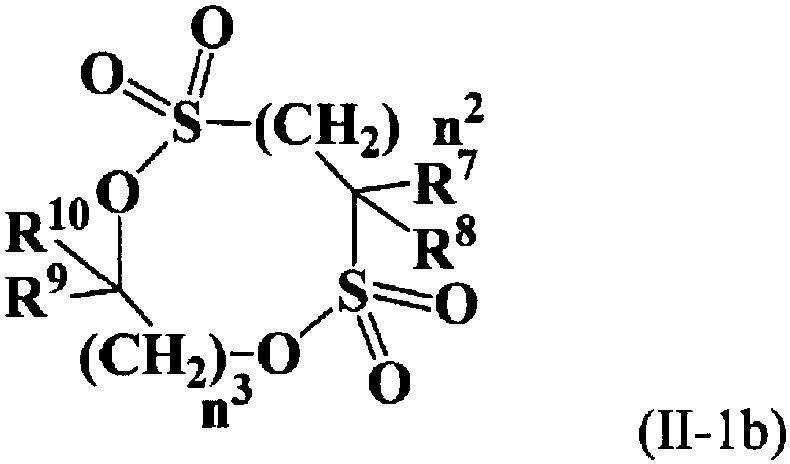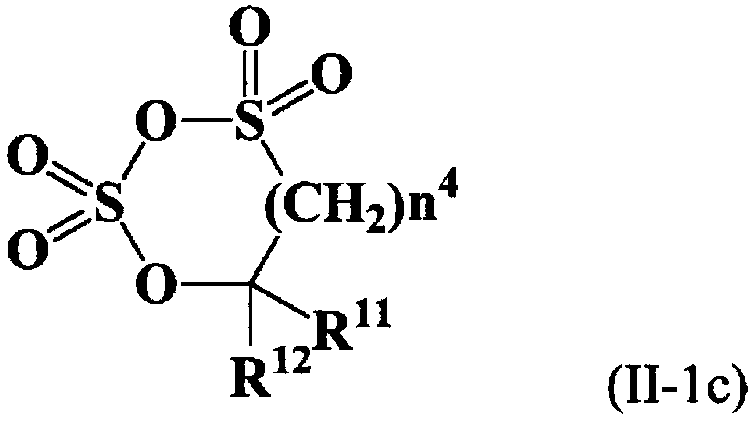Electrolytic solution for nonaqueous electrolytic solution battery, and nonaqueous electrolytic solution battery using same
一种非水电解液、电解液的技术,应用在非水电解质蓄电池、非水电解质、电解质等方向,能够解决电池性能降低、电池膨胀、阻碍锂离子移动等问题
- Summary
- Abstract
- Description
- Claims
- Application Information
AI Technical Summary
Problems solved by technology
Method used
Image
Examples
Embodiment 1-1~1-58
[0213] [Examples 1-1 to 1-58, Comparative Examples 1-1 to 1-43] Evaluation of non-aqueous electrolyte batteries
[0214] High temperature storage characteristics (70°C)
[0215] The following evaluations were performed on the nonaqueous electrolyte solution batteries of Examples 1-1 to 1-58 and Comparative Examples 1-1 to 1-43, respectively.
[0216] First, using the manufactured battery, conditioning was performed under the following conditions at an ambient temperature of 25°C. That is, as the initial charge and discharge, perform constant current and constant voltage charging at a charging upper limit voltage of 4.3V at a rate of 0.1C (3mA), discharge at a constant current at a rate of 0.2C (6mA) until the end-of-discharge voltage is 3.0V, and then charge at a rate of 3.0V. The upper limit voltage is 4.3V, 0.2C rate (6mA) for constant current and constant voltage charging, and 0.2C rate (6mA) for constant current discharge until the end-of-discharge voltage is 3.0V, repea...
Embodiment 2-1~2-47
[0250] [Examples 2-1 to 2-47, Comparative Examples 2-1 to 2-13] Production and evaluation of non-aqueous electrolyte batteries
[0251] By the same procedure as the non-aqueous electrolyte battery of the above-mentioned Example 1-1, the aluminum laminate case battery (capacity 30mAh) equipped with the NCM positive electrode for the test, the graphite negative electrode for the test and the separator made of cellulose were respectively impregnated with Table 6, Electrolyte solutions No.2-1 to 2-47 and comparative electrolyte solutions No.2-1 to 2-13 described in Table 7, thereby making Examples 2-1 to 2-47 and Comparative Examples 2-1 to 2 -13 non-aqueous electrolyte batteries. For these non-aqueous electrolyte batteries, the following evaluations were carried out in the same manner as in Example 1-1 above.
[0252] High temperature storage characteristics (70°C)
[0253] Amount of gas generated during high-temperature storage (70°C)
[0254] Various evaluations (, ) of th...
Embodiment 3-1~3-45、 comparative example 3-1~3-9
[0263] [Examples 3-1 to 3-45, Comparative Examples 3-1 to 3-9] Production and evaluation of non-aqueous electrolyte batteries
[0264] By the same steps as the non-aqueous electrolyte battery of the above-mentioned Example 1-1, the aluminum laminate case battery (capacity 30mAh) with the NCM positive electrode for the test, the graphite negative electrode for the test and the separator made of cellulose were respectively impregnated with those listed in Table 9. Electrolyte No.3-1~3-45 described above, comparative electrolyte No.3-1~3-9, thereby making embodiment 3-1~3-45, comparative example 3-1~3-9 Non-aqueous electrolyte battery. For these non-aqueous electrolyte batteries, the following evaluations were carried out in the same manner as in Example 1-1 above.
[0265] High temperature storage characteristics (70°C)
[0266] Amount of gas generated during high-temperature storage (70°C)
[0267] Various evaluations (, ) of the non-aqueous electrolyte batteries of Exampl...
PUM
 Login to View More
Login to View More Abstract
Description
Claims
Application Information
 Login to View More
Login to View More - Generate Ideas
- Intellectual Property
- Life Sciences
- Materials
- Tech Scout
- Unparalleled Data Quality
- Higher Quality Content
- 60% Fewer Hallucinations
Browse by: Latest US Patents, China's latest patents, Technical Efficacy Thesaurus, Application Domain, Technology Topic, Popular Technical Reports.
© 2025 PatSnap. All rights reserved.Legal|Privacy policy|Modern Slavery Act Transparency Statement|Sitemap|About US| Contact US: help@patsnap.com



